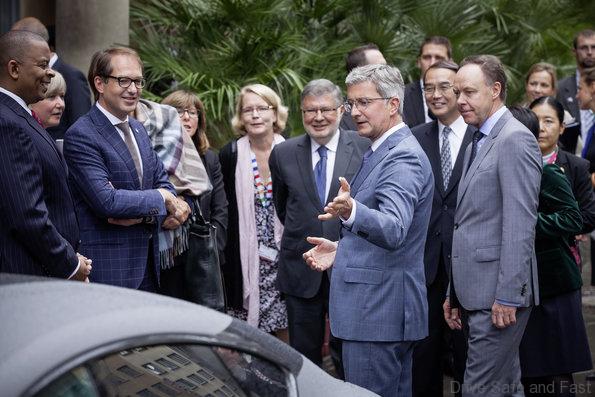A crucial breakthrough has been achieved at the International Motor Show (IAA) in establishing the legal framework of piloted driving and parking. Transport Minister Alexander Dobrindt presented his national strategy for this key technology on Wednesday in Frankfurt. He also welcomed EU Transport Commissioner Violeta Bulc and the transport ministers of the other G7 nations. Using the new Audi A4 and the concept car “Jack,” he presented the current state of driver assist systems to the visitors. The Audi A8 will lead the way in 2017 with capability for piloted driving in stop‑and‑go traffic on the highway at speeds up to 60 km/h (37.3 mph). The new legal framework is intended to allow drivers to abandon their driving tasks as long as the auto pilot is active.
At the presentation for the G7 transport ministers, Audi CEO Stadler described how much the latest Audi A4 has already achieved. Its intelligent driver assistance systems offer a sample of piloted driving to come. This car prevents turning left into oncoming traffic, helps drivers maneuver to avoid dangerous situations, warns of side road traffic when backing up, assists with parking and ensures that passengers do not overlook cars when exiting the car. Audi continues to document its progress in this technology with spectacular demonstrations. In the United States, a driverless Audi TTS etched the brand’s trademark four rings into the surface of a salt flat and also conquered Pikes Peak in the Rocky Mountains. Audi was the first car brand in 2012 to obtain the test license for piloted driving on public roads in the US state of Nevada. In fall 2014 an RS 7 Sportback tested the physical limits of driving without a driver on the Hockenheim racetrack. In early 2015, the Audi A7 piloted driving concept completed a highway drive covering more than 900 km from the West Coast to Las Vegas. A short time later, the technology platform coped with the task of driving in the heavy city traffic of Shanghai.
In April 2015, the German Transport Minister himself experienced the technical capabilities of the Audi A7 piloted driving concept. After that, he announced “fully networked roads” as a long‑term goal that will reduce traffic jams and environmental pollution while optimizing utilization of the infrastructure. The super brain of piloted driving is the central driver assistance control unit (zFAS). It uses the latest high‑performance processors, analyzes signals from numerous sensors in real time, calculates a 3‑D model of the surroundings based on this analysis and then decides how to maneuver. This enables the system to detect vehicles moving into the lane in front of the vehicle – much faster than a human is able to respond.




